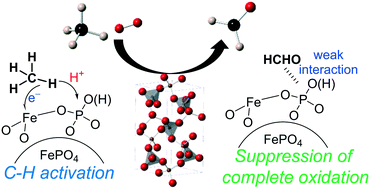Iron phosphate nanoparticle catalyst for direct oxidation of methane into formaldehyde: effect of surface redox and acid–base properties†
Abstract
The effect of various iron phosphate and oxide catalysts on the direct oxidation of methane (CH4) to formaldehyde (HCHO) with molecular oxygen (O2) as the sole oxidant was studied using a fixed-bed flow reactor. Five crystalline iron-containing catalysts (FePO4, Fe3O3(PO4), Fe4(P2O7)3, Fe2P2O7, and α-Fe2O3) with different iron coordination geometries, iron oxidation states, and Fe/P ratios were synthesized by the sol–gel method using malic acid or aspartic acid. The Fe/P molar ratio had a significant effect on the oxidation catalysis; CH4 conversion increased with the Fe/P molar ratio, although the selectivity to HCHO decreased. Trigonal FePO4 nanoparticles synthesized by the malic acid-aided method with an Fe/P molar ratio of 1/1 exhibited the highest activity for the selective formation of HCHO among the catalysts tested, including FePO4 synthesized by a conventional method. Despite the much higher oxidizing ability of Fe2O3 than FePO4, the oxidation of CH4 using Fe2O3 resulted in the formation of only CO2. In contrast, the temperature-programmed reaction of FePO4 with CH4 gave Fe2P2O7 with the formation of HCHO as a primary product, and Fe2P2O7 reacted with O2 to regenerate FePO4. Based on mechanistic studies including the catalyst effect, kinetics, pulse-reaction experiments, and IR spectroscopy, the bulk structural change between FePO4 and Fe2P2O7 is not involved during the catalysis and the surface redox and acid–base properties of FePO4 are considered to play an important role in CH4 oxidation with the structure preservation of bulk FePO4. The combination of redox-active Lewis acidic iron sites and weakly-basic phosphate units likely contributes to the C–H activation of CH4 and the suppression of complete oxidation to CO2, respectively.



 Please wait while we load your content...
Please wait while we load your content...